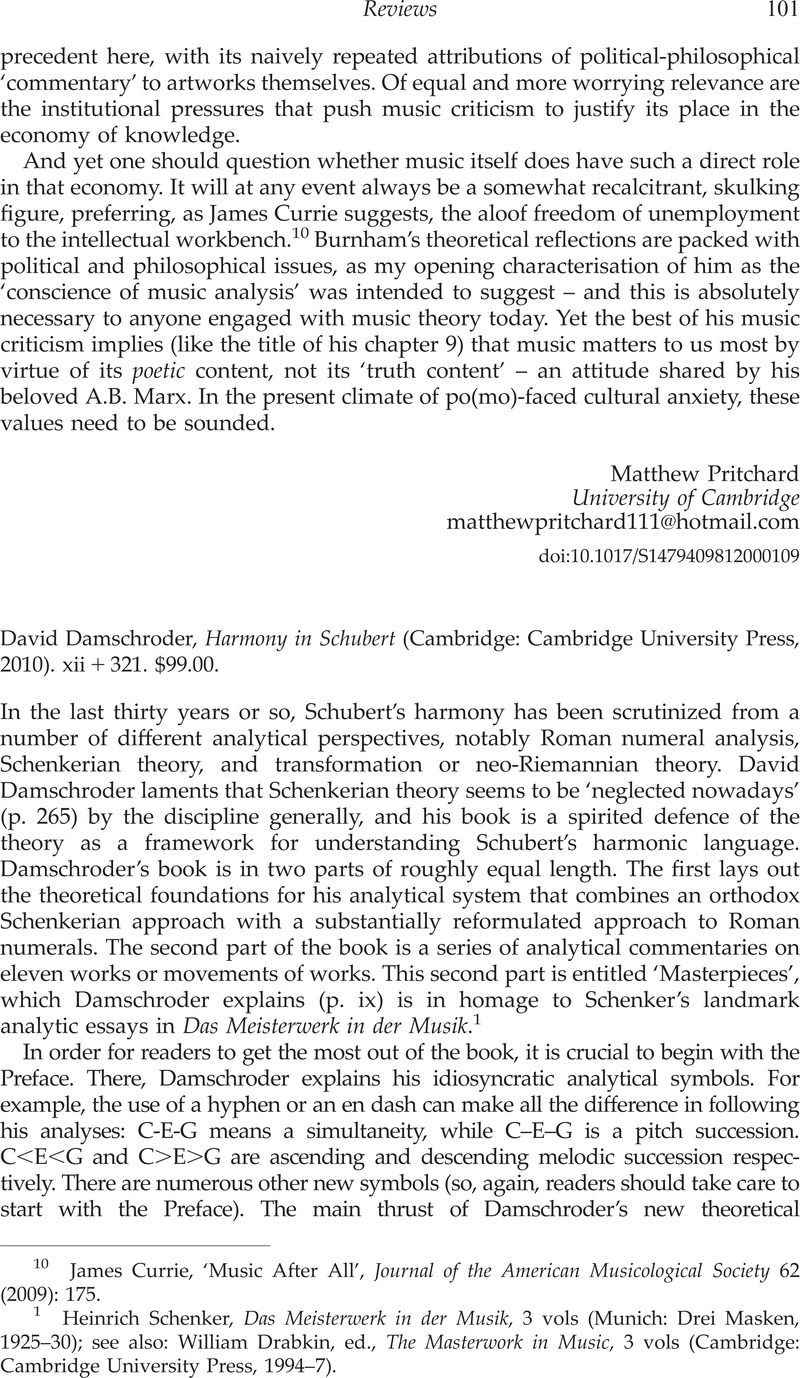Article contents
David Damschroder, Harmony in Schubert (Cambridge Cambridge University Press, 2010). xii+321. $99.00.
Published online by Cambridge University Press: 24 May 2012
Abstract

- Type
- Book Reviews
- Information
- Nineteenth-Century Music Review , Volume 9 , Issue 1: Theoretical and Critical Contexts in Nineteenth-Century Performance Practice , June 2012 , pp. 101 - 106
- Copyright
- Copyright © Cambridge University Press 2012
References
1 Heinrich Schenker, Das Meisterwerk in der Musik, 3 vols (Munich: Drei Masken, 1925–30)Google Scholar; see also: William Drabkin, ed., The Masterwork in Music, 3 vols (Cambridge: Cambridge University Press, 1994–7)Google Scholar.
2 Georg Joseph Vogler (1749–1814), Handbuch zur Harmonielehre und für den Generalbass (Prague: Barth, 1802)Google Scholar; see also Grave, Floyd, ‘Abbé Vogler's Theory of Reduction’, Current Musicology 29 (1980): 41–69 Google Scholar.
3 For the most accessible explanation of Richard Cohn's hexatonic model, see his ‘Maximally Smooth Cycles, Hexatonic Systems, and the Analysis of Late-Romantic Triadic Progressions’, Music Analysis 15 (1996): 9–40Google Scholar. The symbols P and L are explained on p. 12; the ‘Northern’ cycle in Fig. 1 (p. 17) illustrates that A♭ major and E minor appear on opposite poles of the circle, a position in the cycle that also means they share no common tones – hence they are each other's ‘hexatonic pole’.
4 Kopp, David, Chromatic Transformations in Nineteenth-Century Music (Cambridge: Cambridge University Press, 2002)CrossRefGoogle Scholar.
5 See for instance McClary, Susan, ‘Constructions of Subjectivity in Schubert's Music’, in Queering the Pitch: The New Gay and Lesbian Musicology, ed. Philip Brett, Elizabeth Wood, and Gary C. Thomas (New York: Routledge, 1994): 205–233 Google Scholar and ‘The Impromptu that Trod on a Loaf: or How Music Tells Stories’, Narrative 5 (1997): 20–35; Everett, Walter, ‘Deep-Level Portrayals of Directed and Misdirected Motions in Nineteenth-Century Lyric Song’, Journal of Music Theory 48 (2004): 25–68 CrossRefGoogle Scholar, ‘Grief in Winterreise: A Schenkerian Perspective’, Music Analysis 9 (1990): 157–75; Rings, Steven, ‘Perspectives on Tonality and Transformation in Schubert's Impromptu in E♭, D. 899, no. 2’, Journal of Schenkerian Studies 2 (2007): 33–63 Google Scholar.
6 Lewin, David, ‘Auf dem Flusse: Image and Background in a Schubert Song’, 19th Century Music 6 (1982–1983): 47–59 CrossRefGoogle Scholar. A simple translation of the question might read: ‘My heart, do you now recognize your image in this stream?’
7 Lewin, ‘Auf dem Flusse’, p. 47Google Scholar.
8 Clark, Suzannah, ‘Schubert: Theory and Analysis’, Music Analysis 21 (2002)CrossRefGoogle Scholar: especially 231–38.
9 Cohn, Richard, ‘As Wonderful as Star Clusters: Instruments for Gazing at Tonality in Schubert’, 19th Century Music 22 (1998–1999): 213–232 CrossRefGoogle Scholar.
10 Hatten, Robert, Interpreting Musical Gestures, Topics, and Tropes: Mozart, Beethoven, Schubert (Bloomington: Indiana University Press, 2004): 194–198 Google Scholar; Richard Taruskin, The Oxford History of Western Music, vol. 3 [2005] 2010, pp. 107–113Google Scholar.
- 1
- Cited by




